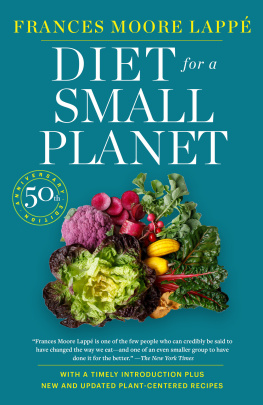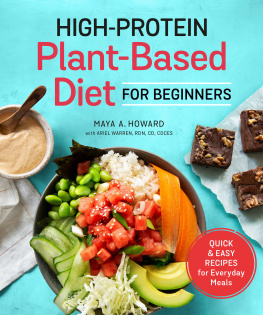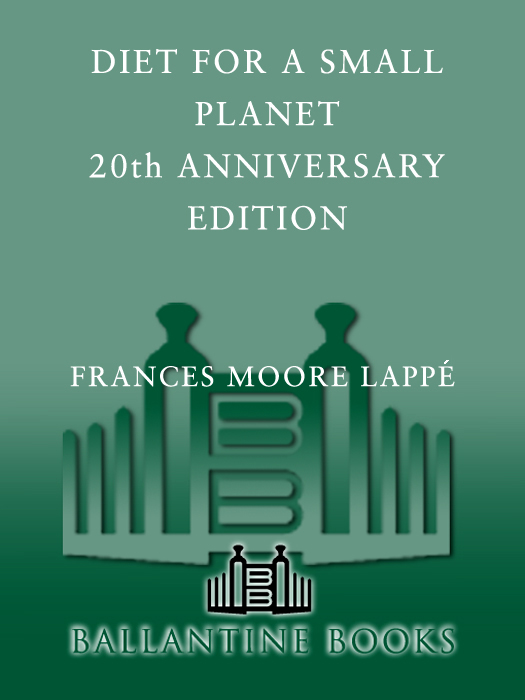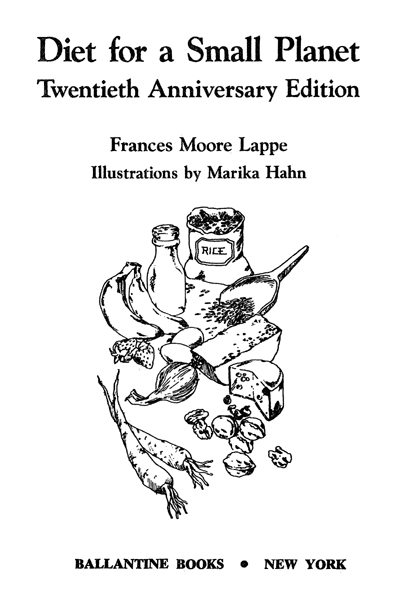Diet For A Small Planet
If youve never read DIET FOR A SMALL PLANET youll find it a warm, caring, human philosophy of how the way we eat affects not only ourselves but our world.
This amazing book is also a complete kitchen guide, filled with tips, suggestions, and delicious recipesa total guide to eating well.
Also by Frances Moore Lappe
Published by Ballantine Books:
GREAT MEATLESS MEALS
FOOD FIRST
WHAT TO DO AFTER YOU TURN OFF THE TV
REDISCOVERING AMERICAS VALUES
A Ballantine Book
Published by The Random House Publishing Group
Copyright 1971, 1975, 1982, 1991 by Frances Moore Lapp
All rights reserved under International and Pan-American Copyright Conventions. Published in the United States by Ballantine Books, an imprint of The Random House Publishing Group, a division of Random House, Inc., New York, and simultaneously in Canada by Random House of Canada Limited, Toronto.
Ballantine and colophon are registered trademarks of Random House, Inc.
Library of Congress Catalog Card Number: 82-1655
eISBN: 978-0-307-75453-0
www.ballantinebooks.com
v3.1
For Betty Ballantine, whose foresight, thank
was better than mine!
Contents
List of Figures
Acknowledgments
In the first edition of this book I included a special acknowledgment to my parents. As I appreciate them even more today than I did ten years ago, I would like to repeat those words: I wish to thank my parents, John and Ina Moore, who, by having always set the finest example of critical openness to new ideas, made this inquiry possible.
I am indebted to Nick Allen, of the Institutes staff, for his support for this project from its inception and for his inspired and very significant editorial contribution.
Mary Sinclair, Cindy Crowner, and Perri Sloane each contributed cooking talent and other skills to improve the recipes in this book and test the many contributions sent in from around the country. For testing and improving recipes I also appreciate the help of Elizabeth Rivers, Julia Rosenbaum, Claire Greensfelder, Myra Levy, Charles Varon, Katie Allen, Vince Bielski, Elinor Blake, Maria Torres McKay, and the Davis, California, Food for All groupespecially Laurie Rubin.
Special thanks go to Jennifer Lovejoy and JoNina Abron, who handled many of my Institute responsibilities so that I could be free to work on this book.
Debbie Fox was the loyal and talented typist of most of this manuscript. Her good humor and her willingness to put up with umpteen drafts will never be forgotten.
Research for this book depended on the help of dozens of people. My special thanks go to Sandy Fritz, Jenny Robinson, and John Moore. I also appreciated the help of Mort Hantman, Tracey Helser, Jim Wessel, Erik Schapiro, David Kinley, Vince Bielski, and Fred Brauneck.
This book benefited greatly from the valuable suggestions of friends and colleagues around the country. I am indebted to Michael Jacobson of the Center for Science in the Public Interest, Marty Strange of the Center for Rural Affairs, William Shurtleff of the Soyfoods Center, to Judy Stone, Robert Greenstein, and Steve Daschle of the Project on Food Assistance and Poverty, to Risk Weissbourd, Cheryl Rogers, and Tom Joe of the Center for the Study of Welfare Policy of the University of Chicago, and to Bard Shollenberger of the Community Nutrition Institute. I also appreciate the time and thought given to this book by Joan Gussow, Nevin Scrimshaw, Isabel Contento, Keith Akers, Robin Hur, Alex Hershaft, Georg Borgstrom, Douglas McDonald, Donald R. Davis, Stan Winter, Jim Spearow, and V. James Rhodes.
I would also like to thank those to whom I am indebted for recipe sections in the first two editions of this book. Many of the recipes they contributed or helped to develop remain in this edition. First, Ellen Ewald who back in 1970 helped acquaint me with the unknown world of whole foods. Second, Susan Kanor whose special kitchen touch and hard work made developing the recipes for the second edition a great adventure.
For other recipes that I have retained in this new book, I am grateful to Barbara Peter, Carol Ackerman Albiani, Sandye Carroll, Diane Coleman, Nancy Posselt, Jackie Potts, Paul Prensky, Joy Gardner, Nancy Meister, Robin McFarlane, and Jamie Seymour.
For their ideas and editorial suggestions I also want to thank Joseph Collins, Charles Varon, Regina Fitzgerald, Jess Randall, and my parents, John and Ina Moore.
And I appreciate all those at the Institute who put up with me during the period of stress to meet this deadline: Gretta Goldenman, JoNina Abron, Joseph Collins, David Kinley, Jim Wessel, Nick Allen, Jess Randall, Annie Newman, and Diana Dillaway.
Finally, I am grateful to my agent, Joan Raines, for her strong support for my work.
Diet for a Small Planet Twenty Years
LaterAn Extraordinary Time to Be Alive
I BEGIN THIS introduction to the 20th anniversary edition of Diet for a Small Planet with a sense of awe, awe at the rapidity of change. In 1971, Ian intense 26-year-old in search of herselfsat long hours in the U.C. Berkeley library uncovering facts about the global food supply that turned my world upside down. At home in my dining room, working at my manual typewriter, I made seemingly endless protein calculations with a slide rule. And here I am twenty years later, tapping away on my Toshiba lap top preparing to FAX this chapter to my editor!
Yes, the pace of technological change has been breathtaking, but our change of consciousness has been yet more dramatic. We who were born in this century are the first generations to experience a perceptible quickening of historical time. The change you or I witness in a lifetime now exceeds what in previous centuries transpired over many, many generations. And we who were born after World II are the first to know that our choices count: They count on a global scale. They matter in evolutionary time. In our species fantastic rush toward modernization we obliterate millions of other species, transfigure the earths surface, and create climate-changing disruption of the upper atmosphere, all powerfully altering the path of evolution.
More personally, I feel the quickening of time in realizing that what was heresy, what was fringe, when I wrote Diet for a Small Planet just twenty years ago is now common knowledge.
Then, the notion that human beings could do well without meat was heretical. Today, the medical establishment acknowledges the numerous benefits of eating low on the food chain.
Then, anyone who questioned the American diets reliance on beefsince cattle are the most wasteful converters of grain to meatwas perceived as challenging the American way of life (especially, when that someone came from Fort Worth, TexasCowtown, USA). Today, the expanding herds of cattle worldwide are not only recognized as poor plant-to-meat converters but are documented contributors to global climate change. Theyre responsible for releasing enormous quantities of methane into the atmosphere, contributing to global warming. Moreover, commercial invasion of the South and Central American rainforests now implicates cattle ranching in the one-and-one-half acre per second destruction of the remaining rainforests worldwide.
Then, anyone who questioned industrial agriculturefossil fuel and chemically dependentwas seen as a naive back to the lander. To challenge industrial agriculture was to question efficiency itself and to wish us all back into the fields at hard labor. Today, the National Academy of Sciences acknowledges the threat of agricultural chemicals










